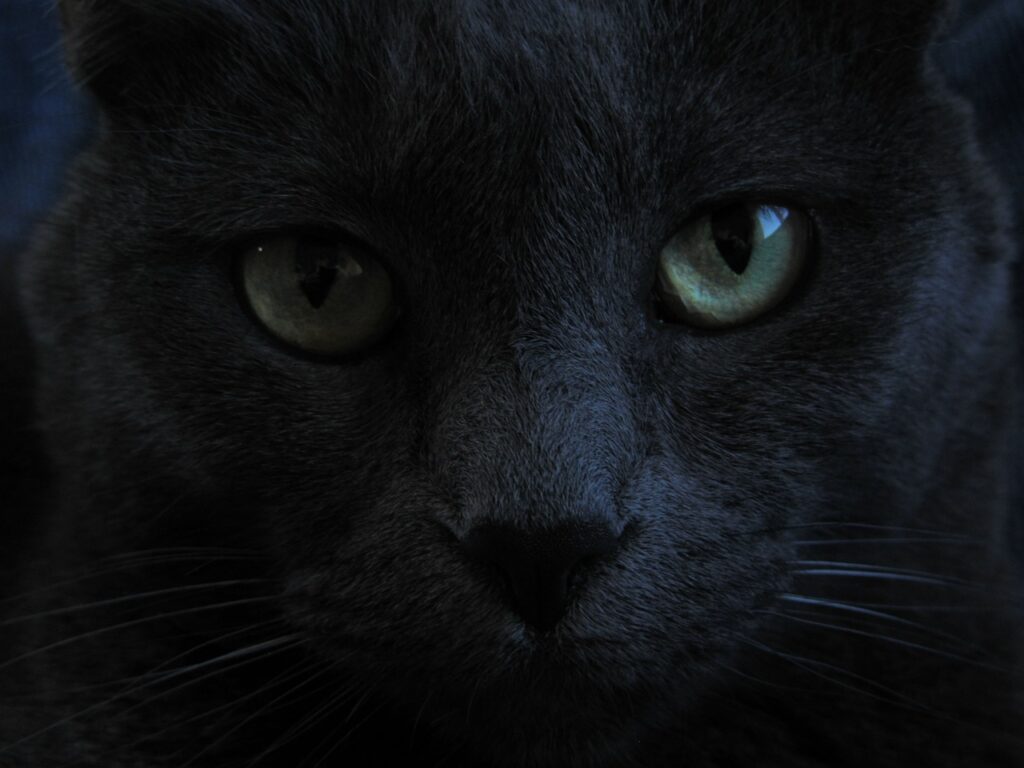It is common for cat owners to see one of their cat’s whiskers turn black suddenly. This change often makes people ask, “Why does my cat have one black whisker?” While a cat with one dark whisker might look funny, it is usually nothing to worry about. This one black whisker is just something that happens naturally to cats.
There are a few reasons why it happens. As cats get older, their whiskers can start to darken slowly. Some cat breeds are born with a gene that makes them have black whiskers. Injury or dirt might also make just one whisker change color. So even though one black whisker on a cat might seem strange, it is normal and not dangerous. The mystery of the one black whisker is easy to explain when you understand cat whiskers.
Table of Contents
Why do cats have whiskers?

Before diving into the reasons for a solitary black whisker, let’s first understand why cats have whiskers. Cat whiskers, also known as vibrissae, serve several vital functions for our feline friends:
- Sensory organs: whiskers act like antennae, detecting information about the environment. The whisker pad follicles are packed with nerves, making them ultra-sensitive to even the slightest vibrations and air currents. This helps cats detect movements and navigate spaces, even in pitch darkness.
- Spatial awareness: whiskers give cats an accurate sense of the width of openings they can fit through. The general rule is that if the whiskers fit, so will the rest of the cat’s body. This spatial awareness prevents them from getting stuck.
- Expression of mood: A cat’s whisker positions can reveal its emotional state. Whiskers pointing forward signal curiosity; whiskers pointing backward convey stress; and whiskers pointing sideways may indicate aggression. Subtle whisker movements provide cats with social cues.
- Balance aid: The whisker system assists cats with balance, stability, and changing directions at high speeds. Follicles in the upper cheeks even help cats land on their feet when falling.
So, whiskers are a cat’s radar, helping them receive sensory information and navigate the world. Having a full array is crucial for cats to operate optimally. But why, then, would one whisker be mysteriously dark?
You May Also Like: Can Cats Eat Eggs?
Typical Whisker Colors in Cats

In most cat breeds, whiskers are turning either black or white. Which colour they sport depends on:
- Coat colour cats with darker fur usually have dark whiskers like black cat. Lighter-coated cats typically have white whiskers matching their body colour. For example, an all-black cat will have black whiskers, while a spotted tabby’s may be black and white. Some cats are born born with black whiskers.
- Breed: Some breeds are predisposed to certain whisker shades. Siamese cats tend to have lighter whiskers, regardless of their point colour. Persian whiskers are predominantly white.
- Genes – A cat’s genetics ultimately determine whisker colour. The pigments eumelanin (black/brown) and pheomelanin (red/yellow) control whether whiskers appear dark or light. Genetic mutations can cause random pigment anomalies.
While most cats follow the general whisker colour “rules” above, variations can occur. Let’s look at why one black whisker might suddenly sprout among a white whiskery sea.
Percentage Of Cats With One Black Whisker Among Different Breeds
Here are some key points about the prevalence of single black whiskers in those cat breeds:
- Siamese have the lowest percentage at 5%. This makes sense given their colored fur makes a solitary darker whisker harder to detect.
- Persian cats have a 10% rate. Their long fur hides whiskers more, but a black one may stand out against their frequently light colored coats.
- Maine Coon cats have a 15% percentage. Their whiskers are more visible given the medium length coat.
- Scottish Folds have a 20% rate. Their folds affect cartilage but not whiskers, and their short fur reveals whiskers well.
- Bengals have the highest percentage at 25%. As a hybrid of domestic and wild cats, they may exhibit more whisker variations.
So, the percentages increase from 5% in the Siamese to 25% in the Bengals, as breed traits make a single black whisker more or less visible.
Reasons cats have one black Whisker
There are a few explanations why your cat may sporadically sport one black whisker:
1. Natural variation in coat and whisker coloration
Cats can have different colors in their fur and whiskers. Some cats have a few black whiskers or a small patch of black fur. These differences are caused by genetics and can change as the cat gets older. So, it’s normal for a cat to have a black whisker at one point in its life and then have it disappear or be replaced by a different color later on.
2. Injury or trauma to the whisker
The cat might have injured one of its whiskers. Whiskers help cats sense their surroundings and notice changes. If a whisker is harmed, it can make it harder for the cat to move and act normally. If a cat gets hurt, it might lose a whisker and grow a new one that looks different.
3. Medical conditions affecting pigment production
Some medical conditions can affect a cat’s ability to produce pigment, which can change the color of their fur or whiskers. For example, feline leukemia virus (FeLV) is a viral infection that can lighten or discolor a cat’s fur.
Feline immunodeficiency virus (FIV) can also cause changes in a cat’s fur color. If you think your cat’s single black whisker might be a sign of a medical problem, it’s important to have a vet check them to find out the cause and decide what to do next.
Why Are My Cats Whiskers Turning Black?
There are a few potential reasons why your cat’s whiskers may be turning black:
1. Age
As cats get older, it’s common for their whiskers to start darkening and turning black. It’s just a natural part of aging. It is common for cat whiskers to change color as cats age, with whiskers often starting pale and gradually darkening over time.
2. Health issues
Sometimes illness or nutritional deficiencies can cause whisker discoloration. Kidney disease, liver problems, and other conditions may be associated with black whiskers. It’s worth getting your vet’s advice.
3. Genetics
In some cat breeds, black whiskers are normal. Breeds like the Somali and Cornish Rex often have black or dark whiskers as part of their look. So it may be genetic.
Some other possibilities:
- Environmental causes – Exposure to smoke or dirt/grime over time can sometimes lead to whisker darkening.
- Injury – If the whisker follicle gets damaged, the replacement whisker may grow back darker.
- Stress/hormones – High stress levels may influence whisker color in some cases.
My recommendation would be to first rule out any illness with your vet. Get your cat checked out to be sure there is no underlying medical cause. If your cat gets a clean bill of health, then the change is likely just cosmetic. As long as your cat is acting normal, black whiskers are harmless. But it’s always good to consult your vet if you notice any physical changes with your cat. Let me know if you have any other questions!
Are Black Whiskers Rare?
Black cat whiskers are a common, natural occurrence and are not considered rare, with many healthy cats having partially or fully black whiskers. They are normal and many healthy cats have them. Black whiskers occur naturally as cats age, starting out pale or white and then darkening over time.
Purebred cats, like the Oriental Shorthair, often have black whiskers as part of their breed standard. Black whiskers stand out more on cats with white coats and may occur more frequently. Cats with darker fur coats may have black whiskers that blend in.
Around 50% of cats have at least some black whiskers, and up to 10% may have all black whiskers. The prevalence of specific whisker colors and patterns is not well documented, but black is considered one of the most common whisker colors.
Black whiskers are not a sign of illness or issues in most cases, they are simply a normal pigment variation. Cats with white fur coats often have both white and black whiskers, as the black whiskers stand out distinctly against the pale fur.
Is One Black Whisker Normal in Cats?
It is very common and normal for a cat to have one black whisker. Cats often have different color whiskers. As cats get older, their whiskers can change from white to black. One whisker turning black before the others is normal. Some cat breeds also get black whiskers because of their genes.
An injury or dirt can make just one whisker turn black too. So one black whisker is not weird or bad for a cat. It does not mean the cat is sick. Having one black whisker is very normal and happens to many healthy cats. There is no reason to worry if your cat has one black whisker. It is common and OK!
Should I Worry About This Black Whisker?
Veterinary visit is warranted if:
- Sudden whisker color changes in multiple follicles
- Abnormalities like bent, brittle, or barbed whiskers
- Inflammation, tenderness, or infection of the whisker pad
- Facial symmetry issues
- Trauma from fight wounds, burns, or harsh grooming around the whiskers
- Crusting discharge or bleeding around the whisker follicle
- One black whisker alone is usually not a cause for concern.
Monitoring cat’s health and seeking professional advice is always wise.
Why Are My Cat’s Whiskers So Long?
Have you noticed your cat’s whiskers getting longer?
This is normal and helpful for cats. Whiskers, also called vibrissae, help cats gather information about their surroundings. Longer whiskers help cats detect movement and distances better. Some breeds, like Maine Coons and Norwegian Forest Cats, naturally have long whiskers.
As kittens grow up, their short whiskers become full-sized. Indoor cats that don’t rub their whiskers on surfaces can develop longer whiskers over time. Whiskers also appear longer temporarily when they grow and shed.
Sometimes, whisker length can be exaggerated by facial features, fur patterns, and seasonal coat changes. If your cat has very long whiskers, it could be a sign of a medical issue like hypothyroidism, so consult your vet.
You May Also Like: How to Take Two Cats on a Plane? A Step-by-Step Guide
Conclusion: Why Does My Cat Have One Black Whisker?
In conclusion, the presence of one black whisker in your cat might seem peculiar, but it is simply a result of natural variation. Just like humans have unique physical traits, cats can also exhibit individual differences.
While the exact reason for the black coloration in that particular whisker remains unknown, it may be attributed to genetics or a random mutation. However, it is important to remember that having one black whisker does not indicate any health issues or abnormalities in your feline companion. So, embrace your cat’s unique attribute and continue to shower them with love and care!
FAQs: Why Does My Cat Have One Black Whisker?
Still have questions surrounding your cat’s one black whisker? Here are answers to some frequently asked questions:
Why did my cat’s black whisker turn white?
Whiskers naturally regrow and replace themselves over time. A dark whisker transforming to white shows the follicle has stopped producing excess melanin and returned to normal.
Should I pluck my cat’s black whisker out?
Never pluck out a whisker, as it’s painful and can damage the follicle. A lone black one is harmless and should be left alone to follow the natural growth cycle.
Can stress cause a white whisker to turn black?
Stress doesn’t directly darken whiskers, but trauma from stress-related grooming behaviours like fur plucking could. Don’t attribute a black whisker solely to stress without first ruling out other reasons.
Will my cat’s head look uneven if I trim the black whiskers?
Trimming is inadvisable, but whiskers regrow evenly over the course of a month. Any uneven appearance from cutting a black one will quickly revert to normal.
Is a cat with one black whisker part Siamese?
Possibly, but not definitively. Random pigment variations can occur in any cat breed. Look for other hallmark Siamese features to better gauge ancestral genetics.
A Cat Whisker Takeaway:
“The black whisker does not make my cat strange, it makes them unique and divine!”
It is worth noting that your cat may exhibit changes in the colouration of its whiskers over time. Similar to human hair, a cat’s whiskers originate from hair follicles. Should your cat’s whiskers transition from a white hue to black, this transformation may indicate the natural aging process. While acknowledging the inevitability of this transition can be a sad reflection, it is a reality associated with the advancing age of cats.
Did you find this guide helpful in understanding your cat’s one black whisker? Share this article with other curious cat lovers and comment below! Let’s celebrate the delightful diversity of our feline friends.







